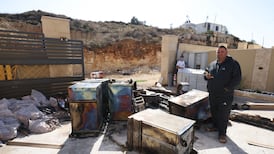Workers have cleared 99 per cent of war rubble and debris in the ancient souq at the heart of the Old City of Homs, in western Syria, which was ravaged by warfare between 2011 and May 2014 when insurgents withdrew under a UN-monitored evacuation plan.
The first two-month phase of the UN Development Programme project to reconstruct the souq, covering 10-20 per cent of the Old City, has been nearly completed and work has begun on the second phase, which is restoration of the infrastructure and built heritage of a souq that is 3,500-4,000 years old. Its current structures date to the 13th century Ayyubid dynasty founded by warrior king Saladin.
Old skills and original materials – local black volcanic stone, wood and metal – are being used to replicate its 4,600 shops as they were a century ago, says Ghassan Jansiz, the architect supervising the effort.
As we walk beneath the metal vault transformed into lacework by bullets and shrapnel, he says that, fortunately, this was mainly a passage rather than a battleground so the destruction is not as extensive as in other areas. It was, however, completely looted.
The pillage continued after fighters had left when thieves levered distinctive features from walls and windows, particularly carved stone symbols based on those used in Roman times to identify products sold in each narrow street – perfumes, clothes, carpets, or spices and coffee.
Economic power
At the battle-scarred and scorched Nouri mosque, one of the largest in Syria during the 12th century when Homs was a political and economic power in the land, Jansiz points out columns dating to a Roman era pagan temple converted into a church during the Byzantine period and a mosque under the Muslims.
After the conflict, paintings covered for decades were revealed, he says. “Homs is a Sufi city, both Muslim and Christian, so decoration on buildings is spare,” he says – but details are elegant and functional.
On one street, workmen carefully tap into place thin slates with earth between them rather than cement. We walk from room to room in the largest and best preserved of the Ottoman hammams (bath houses) which conform to the ancient Roman model. We take chairs at a table in the Khan, an inn, where the 35 young architects and engineers involved in the project drink tea as they pore over plans and discuss their investigations of buildings never before documented.
The third phase of the project involves convincing shopkeepers to return to the souq but, since several have already reopened, others can be expected to follow. A grinning sock merchant says that “business is getting better every day”. During the fourth phase handicrafts are to be introduced.
Pilot project
UN Development Programme country director Samuel Rizk argues the souq serves as a pilot project for other reconstruction in the Old City itself and elsewhere. The old quarter in the Christian town of Maaloula, damaged by fighting in 2013-14, has been cleared of rubble as well. The programme’s aim is to get “people to stay in their homes by providing water and electricity”.
Without services “they leave and become part of the humanitarian crisis”. Jobs are offered to “a couple of thousand of the most vulnerable”, reducing displacement and the pressure of refugees on neighbouring countries, and on Europe.
Director of antiquities Maamoun Abdulkarim says the work in Homs is being closely supervised by his department. “They cannot restore a [traditional] home or shop in the Old City without our permission and observing international norms” for dealing with historic buildings, he says.
He warned that emergency work has to be carried out to halt deterioration in Homs, Maaloula, and Palmyra. "But we can't do anything in Aleppo, " he says.
“Aleppo is Syria’s most important city damaged by war. I am sure we have lost [Aleppo’s rich cultural heritage]. Aleppo’s damage is greater than all the damage elsewhere put together. Aleppo is the symbol of the tragedy of Syria’s cultural heritage.”










